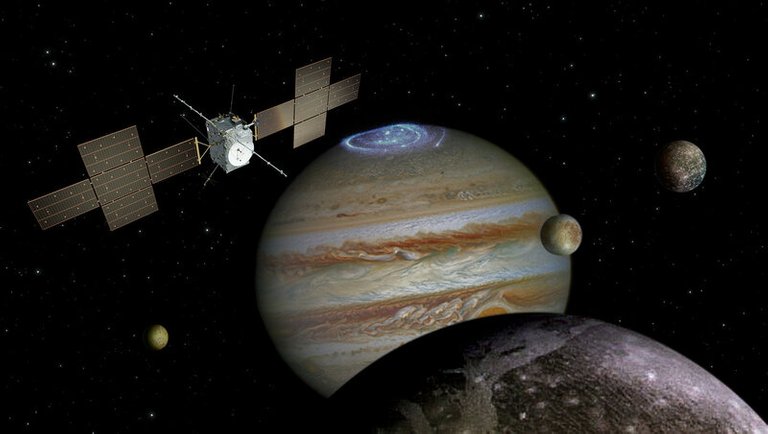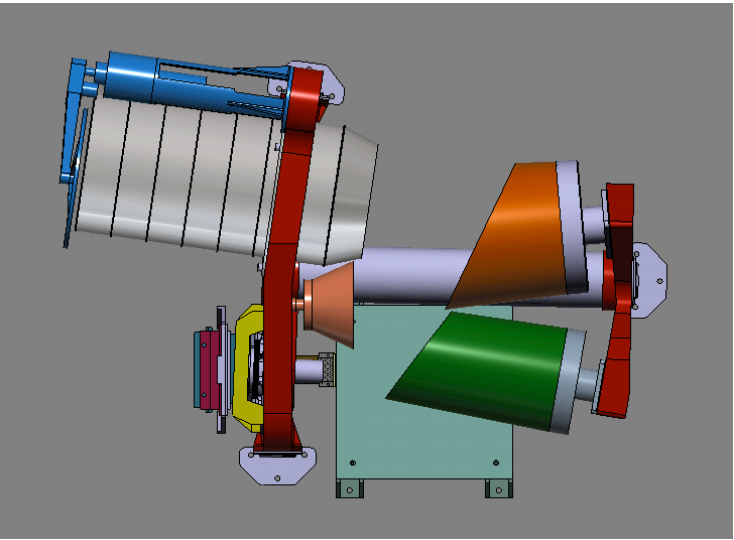JUICE (JUpiter ICy moons Explorer) - next flagship ESA mission to explore Jovian system. Its final design is approved by ESA, and the construction is being overseen by Airbus Defence and Space. After launch in 2022 JUICE will reach the goal in 2029. At Jupiter's orbit JUICE will spend three-and-a-half years, examining the giant planet's turbulent atmosphere, enormous magnetosphere, its set of tenuous dark rings and its satellites. During multiple flybys it will study the large icy moons Ganymede, Europa and Callisto, which are thought to have oceans of liquid water beneath their icy crusts – perhaps even harbouring habitable environments. Then the mission will culminate in a dedicated, eight-month tour around Ganymede - the biggest moon in Solar System and the only one having own magnetosphere.

Image: spacecraft: ESA/ATG medialab; Jupiter: NASA/ESA/J. Nichols (University of Leicester); Ganymede: NASA/JPL; Io: NASA/JPL/University of Arizona; Callisto and Europa: NASA/JPL/DLR
The spacecraft’s solar panels form a distinctive cross-shape totalling 97 sq m, the largest ever flown on an interplanetary mission (for comparison: current record is set by Juno mission - 60 sq m). After arrival at Jupiter they will generate 850 Watts - no more then power supply of average desktop PC. This is however more than enough for the laboratory of 11 scientific instruments.
Juice’s camera called JANUS and provided by NASA, will capture exquisite details of the moon’s features, as well as identify the ices and minerals on their surfaces.

Image: NASA - scheme of the JANUS camera
Instead of familiar glass lens, the optical solution adopted as JANUS camera baseline is a Three Mirror Anastigmat (TMA). The camera is composed by three mirrors sharing the same optical axis. The image sensor has resolution 2000 x 1504 pixels which does not seems great even for cheap smartphone camera - but only for the the first glance. It captures images in enhanced range from infrared to ultraviolet light and powerful telescope optics will allow to obtain images with resolution up to 10 m/pixel from the distance 500 km.
The spacecraft will also include booms such as a 10 m-long magnetometer mast (seen towards the bottom of JUICE in the first image), a 16 m radar antenna (the long boom across the top), and antennas to measure electric and magnetic fields.
Mission will start atop of the Ariane-5 rocket. As it is not powerful enough to lift spacecraft with fuel, sufficient to get directly at Jupiter's orbit , it'll need to pass through a series of gravitational manoeuvers at Venus, Earth and Mars:
JUICE will become the first European mission on Jupiter's orbit and third after NASA's Galileo and JUNO.
Great post @busser! The Juice mission is perhaps the ESA mission that excites me the most (together with ExoMars). Been very jealous of my other young professional friends who got to work with this project while they were at ESTEC.
12 years to arrival - waiting .. waiting.. you have to find there some alien monolith or maybe alien mummy in Arctic (even fake) just to push it ahead
Luckily there are many other missions to follow in the meantime :) as well as new developments in commercial space that will blow our mind between now and 2029.
This post received a 2.1% upvote from @randowhale thanks to @busser! For more information, click here!
I got a bellyRub and this post has received a 0.52 % upvote from @bellyrub thanks to: @zeartul.
And not only the camera(s), spectrometers are usually forgotten, but they are kind of the most interesting instrumetns to carry at a S/C. For me, JUICE specially carries some dust analyzers that are going to surprise us for sure.
Just discovered your blog, nice one!